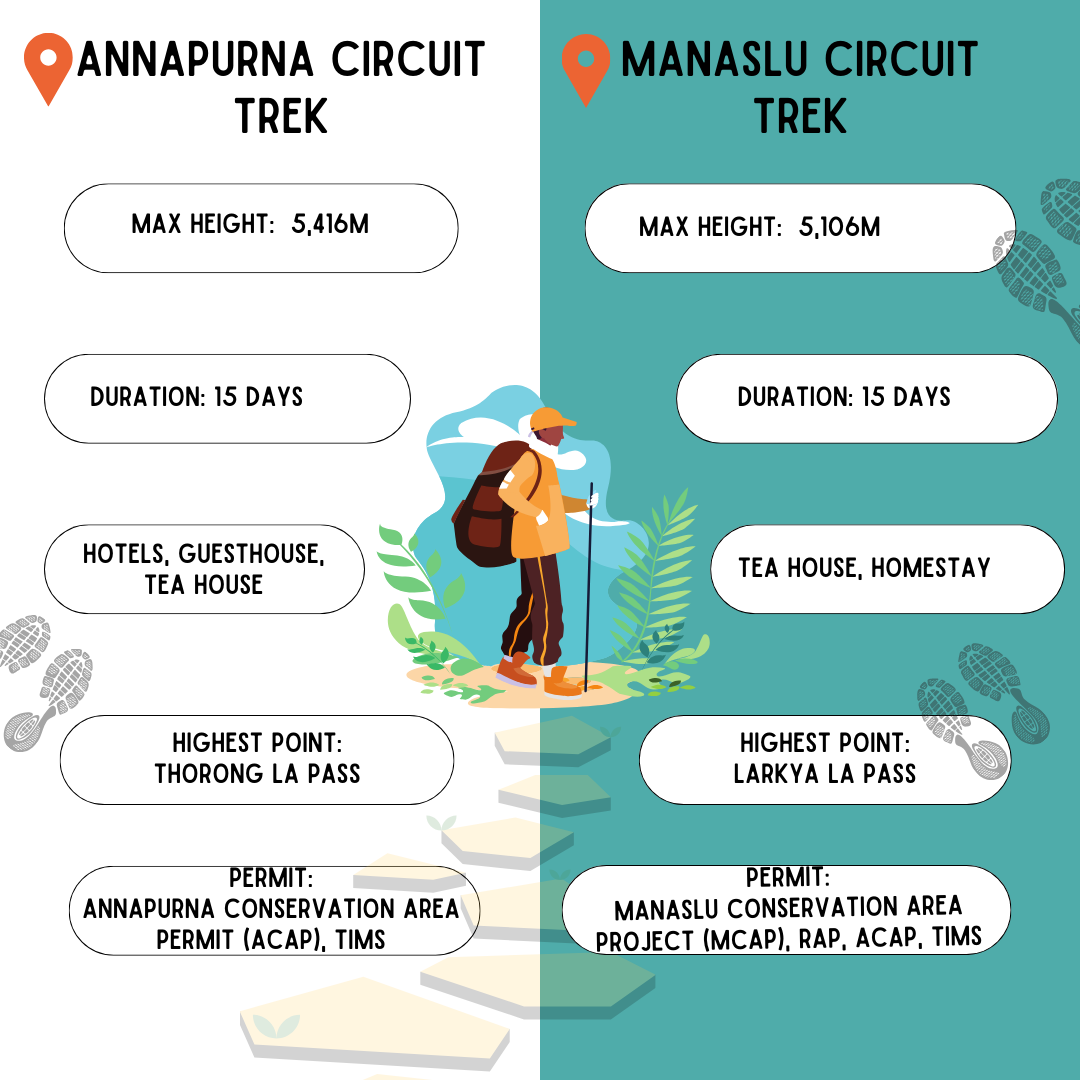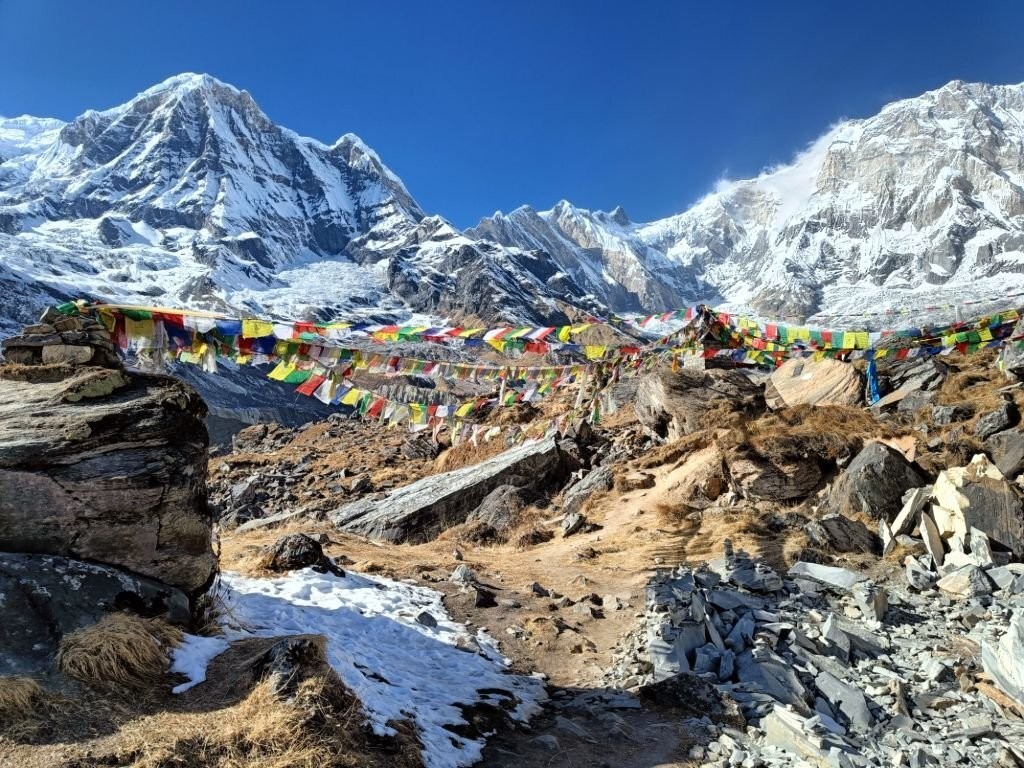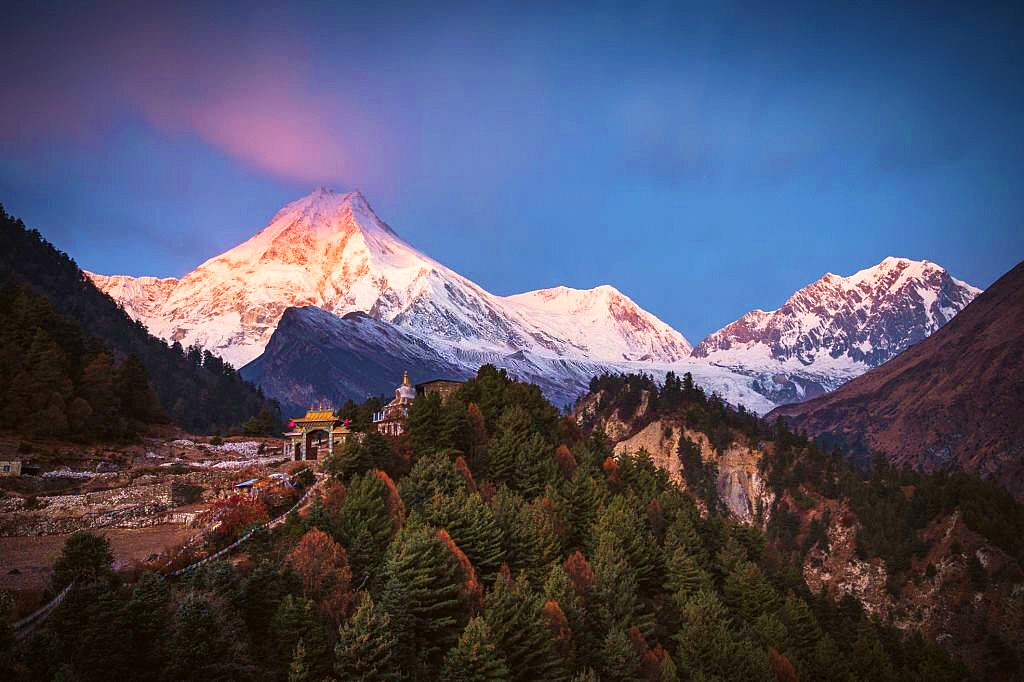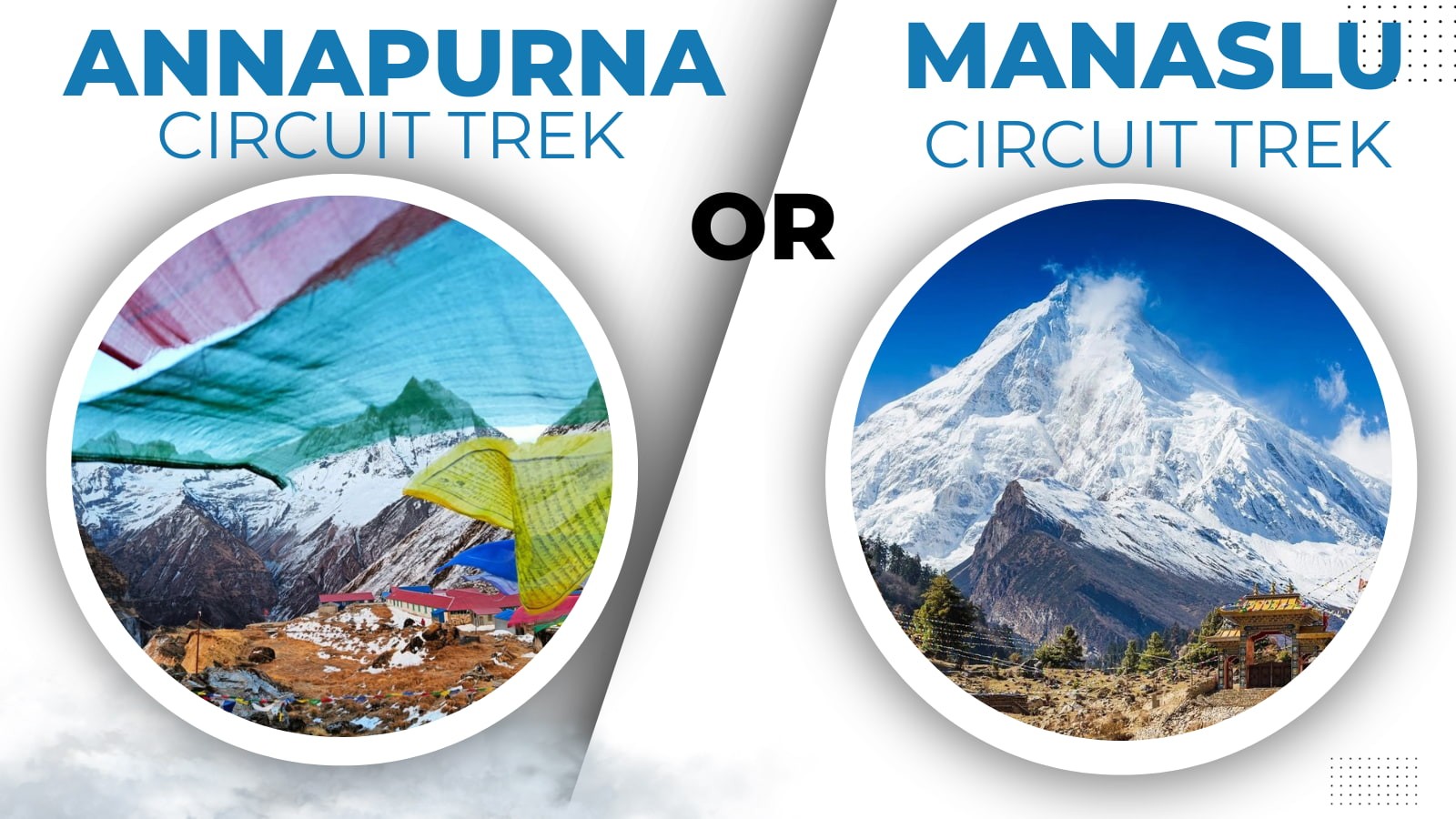Trip Highlights:
Annapurna Circuit Trek-ACT Highlights:
- Thorong La Pass: The highest point of the trek, offering panoramic views of the Annapurna Massif.
- Diverse Terrain: From subtropical forests to alpine meadows and high mountain deserts.
- Cultural Immersion: Opportunity to experience the rich cultural heritage of the Annapurna region, including Tibetan Buddhist and indigenous communities.
- Varied Wildlife: Possibility to spot diverse species of flora and fauna.
- Hot Springs at Tatopani: A relaxing experience that offers a break from the trek.
- Sunrise at Poon Hill: One of the most famous viewpoints in Nepal for sunrise and panoramic mountain views.
Manaslu Circuit Trek-MCT Highlights:
- Larkya La Pass: The highest point (5160 meters) on the Manaslu Circuit, offering dramatic views of Manaslu and other Himalayan peaks.
- Remote Trails: Less crowded paths, offering a more secluded trekking experience.
- Rich Culture: Immersion in the unique Tibetan-influenced culture of the Nubri people.
- Manaslu Base Camp: An optional detour that takes you to the base of the world's eighth-highest mountain.
- Diverse Ecosystems: From subtropical woodlands to arid terrains, offering a range of sceneries and wildlife.

Highest Points of Manaslu Circuit Trek and Annapurna Circuit Trek:
When it comes to trekking in Nepal, one of the most exhilarating aspects is the ascension to significant altitudes. Both the Annapurna Circuit Trek and the Manaslu Circuit Trek offer pinnacle moments - points of the trek where you’ll find yourself standing at dizzying heights, awed by the beauty that surrounds you.
- Annapurna Circuit Trek - Thorong La Pass (5,416m)
The apex of the Annapurna Circuit Trek is the Thorong La Pass, standing at an awe-inspiring altitude of 5,416 meters (17,769 feet) above sea level. It’s an exhilarating and challenging section that offers panoramic views of the surrounding Annapurna Massif and other peaks. Reaching Thorong La Pass is not just a physical achievement but also an emotional one, a point on the trek that is often met with euphoria and a sense of accomplishment. The views are simply spectacular, providing a 360-degree vista of towering peaks, including Annapurna, Dhaulagiri, and several others.
- Manaslu Circuit Trek - Larkya La Pass (5,106m)
The tallest spot you'll reach during the Manaslu Circuit Trek is the Larkya La Pass, sitting way up high at 5,106 meters (16,752 feet) above sea level.
While slightly lower than Thorong La, Larkya La is no less dramatic. The pass offers stunning views of Manaslu, the eighth-highest mountain in the world, along with other peaks such as Annapurna II and Cheo Himal. The air is thin, the atmosphere solemn, and the vistas are awe-inspiring. Larkya La serves as the grand culmination of the Manaslu journey, rewarding trekkers with sights that remain etched in memory long after the trek is over.
Both these highest points serve as the crescendo of their respective treks, spots where trekkers often pause to take in the enormity of what they’ve accomplished. They also provide unmatched opportunities for photography and moments of contemplation.
Annapurna Circuit Trek and Manaslu Circuit Trek: Difficulty Level:
When considering a trek in Nepal's Himalayas, it's essential to evaluate the level of difficulty to ensure a fulfilling and safe experience. Both the Annapurna Circuit Trek and the Manaslu Circuit Trek come with their own sets of challenges, but also offer options for trekkers with various levels of experience.
- Annapurna Circuit Trek: Difficulty Level
The Annapurna Circuit Trek is generally considered moderate to difficult. This is due to several factors such as the long duration of the trek, the varied terrains, and the steep ascents and descents. However, what makes this trek manageable for many is its well-defined paths and ample trekking facilities along the route.
The most challenging part of the trek is the ascent to Thorong La Pass at 5,416 meters. Altitude sickness is a concern here, so proper acclimatization is critical.
- Physical Condition & Experience Requirements
For the Annapurna Circuit Trek, physical fitness is a must. However, technical climbing skills are generally not required. Most people with a good level of fitness and some long-distance hiking experience can successfully complete this trek.
Manaslu Circuit Trek: Difficulty Level
The Manaslu Circuit Trek is often classified as moderate to challenging. This trek involves traversing remote areas, and the trails are not as well defined as those on the Annapurna Circuit. The trek crosses numerous suspension bridges, traverses steep slopes, and involves a demanding climb to the Larkya La Pass at 5,106 meters.
- Physical Condition & Experience Requirements:
For the Manaslu Circuit Trek, a higher level of trekking experience is advisable. The trek is less commercialized, meaning fewer amenities and more rugged conditions. Trekkers need to be prepared for some strenuous days and should be well-acclimated to handle the high altitudes.
Permit Requirements for Annapurna Circuit Trek and Manaslu Circuit Trek:
One of the crucial aspects to plan for when embarking on a trek in Nepal are the necessary permits. Both the Annapurna Circuit Trek and the Manaslu Circuit Trek have specific permit requirements that you must fulfill to legally and safely undertake these journeys. Here's a rundown of what you'll need:
✔ Annapurna Circuit Trek: Permit Requirements:
For the Annapurna Circuit Trek, two main permits are generally required:
- Annapurna Conservation Area Permit (ACAP): This permit is essential for anyone looking to trek in the Annapurna Conservation Area. It is available in Kathmandu or Pokhara and aims to contribute to the sustainable management of the region.
- Trekkers’ Information Management System (TIMS) Card: This is a basic trekking permit obtained to ensure the safety and security of trekkers in the Annapurna region.
✔ Manaslu Circuit Trek: Permit Requirements:
For the Manaslu Circuit Trek, the permit requirements are a bit more complex due to its location in a restricted area:
- Manaslu Conservation Area Project (MCAP) Permit: Similar to ACAP for Annapurna, this permit is mandatory for trekking in the Manaslu region.
- Restricted Area Permit (RAP): As Manaslu lies in a controlled area, a special permit is required for trekkers to access this region.
- Annapurna Conservation Area Permit (ACAP): If your Manaslu Circuit Trek itinerary extends into the Annapurna region, you'll also need an ACAP.
- Trekkers' Information Management System (TIMS) Card: Like Annapurna, a TIMS card is required for Manaslu as well.
It’s crucial to have all necessary documents, including a valid passport and photos, when applying for these permits. Also, due to the restricted nature of the Manaslu Circuit Trek, it is mandatory to do the trek with a registered trekking agency. The permits ensure not only your legal access to these incredible areas but also contribute to the preservation and sustainability of these stunning regions.

Annapurna Circuit Trek and Manaslu Circuit Trek: Itinerary Comparision:
Annapurna Circuit Trek
Day 01 : Arrival in Kathmandu(1400m) and Transfer to Hotel
Day 02 : Trekking Preparation Day
Day 03 : Drive from Kathmandu to Besisahar(760m)
Day 04 : Drive Besisahar to Chame (2710m)
Day 05 : Trek to Upper Pisang (3185m)
Day 06 : Trek to Ngawal (3657m)
Day 07 : Trek Ngawal to Manang (3,519m)
Day 08 : Acclimatization Hike to Ice lake or 100 lama gompa or Gangapurna View Point
Day 09 : Trek to Yak Kharka (4195m)
Day 10 : Trek to High Camp(4,880m)
Day 11 : Cross Thorong La Pass (5,416m) and descend to Muktinath (3,800m)
Day 12 : Drive Muktinath to Tatopani (Hot Springs), by bus (1,190m)
Day 13 : Trek to Ghorepani (2874m)
Day 14 : Hike to Poon Hill(3210m) early morning to see sunrise and Trek down to Pokhara
Day 15 : Drive to Kathmandu(1400m)
https://www.beyondthelimitstreks.com/annapurna-circuit-trek
Manaslu Circuit Trek
Day 01 : Arrive at Kathmandu (1400m)
Day 02 : Trekking preparation day and sight seeing in Kathmandu valley
Day 03 : Drive Kathmandu to Machhe Khola (890m)
Day 04 : Machhe Khola trek to Jagat(1,350m)
Day 05 : Jagat to Deng(1,860m)
Day 06 : Deng trek to Namrung (2,630m)
Day 07 : Namrug trek to Lho village (3,180m)
Day 08 : Lho village trek to Sama Gaun (3,530m)
Day 09 : Sama Gaun (Rest day for acclimatization)
Day 10 : Sama Gaun trek to Samdo(3875m)
Day 11 : Samdo trek to Dharmasala(4460m)
Day 12 : Dharamsala trek to Larkya La Pass(5,106m) descend to Bimthang(3590m)
Day 13 : Bimtang trek to Gho (2,515m)
Day 14 : Trek from Gho to Dharapani and drive to Beshisahar and drive to Kathmandu or pokhara
Day 15 : Free from Program or Departure to Airport
https://www.beyondthelimitstreks.com/manaslu-circuit-trek
Best Season for Annapurna Circuit Trek and Manaslu Circuit Trek:
Timing is a key factor when planning a trek in the Himalayas. The weather conditions can greatly impact your experience, affecting everything from visibility to trail conditions.
✔ Annapurna Circuit Trek: Best Season

The Annapurna Circuit Trek can be undertaken at various times throughout the year; however, certain seasons offer a more favorable trekking environment.
- Autumn (September to November): This is the most popular season for trekking in the Annapurna region. The monsoon rains have cleared the dust, offering excellent visibility. The weather is generally stable and moderate in temperature.
- Spring (March to May): This is the second most popular time of the year for this trek. The weather is warm, and the trails are adorned with blooming flowers like rhododendron, adding a colorful aspect to the trek.
Also Read: Challanges and Rewards of Annapurna Circuit Trek in Winter
It’s advisable to avoid the monsoon season (June to August) due to slippery trails and leeches, and winter (December to February) due to heavy snowfall, particularly in the higher regions.
✔ Manaslu Circuit Trek: Best Season

The Manaslu Circuit Trek also has optimal seasons that offer the best trekking experience:
- Autumn (September to November): Like Annapurna, autumn is the most favorable season for Manaslu Circuit Trekking. The weather is stable, and visibility is excellent. This is particularly important for enjoying the grand vistas of Manaslu and surrounding peaks.
- Spring (March to May): This season is also suitable for Manaslu, offering warm temperatures and clear skies. However, as the Manaslu Circuit Trek is less crowded, Spring can be an excellent time for those looking for a more solitary experience.
Similar to Annapurna, the monsoon and winter seasons are less ideal for trekking the Manaslu Circuit due to the reasons of safety and comfort.
Selecting the right season for your trek is crucial for maximizing your experience and safety. Whether you opt for the Annapurna Circuit Trek or the Manaslu Circuit Trek, aligning your adventure with the most favorable conditions will greatly enhance the quality of your trek.
Accommodation and Meals During Annapurna and Manaslu Circuit Trek:
Accommodation and sustenance are pivotal to any trekking experience, directly affecting your comfort, energy levels, and overall enjoyment of the journey. Both the Annapurna Circuit Trek and the Manaslu Circuit Trek offer a range of options, but there are nuances that deserve attention.
Accommodation and Meals in Annapurna Circuit Trek
The Annapurna Circuit Trek boasts well-developed infrastructure owing to its popularity:
- Teahouses: The most prevalent form of accommodation, teahouses also provide meals. Expect local cuisine like dal bhat (rice and lentils), momo (dumplings), and basic international dishes like pasta and pizza.
- Guesthouses: Offering more amenities than teahouses, guesthouses often have a more extensive menu, featuring both Nepali and Western cuisine.
- Hotels: In gateway cities like Besisahar and Pokhara, standard hotels provide a wider variety of meals, including continental breakfasts and multi-cuisine dinner options.
Accommodation and Meals in Manaslu Circuit Trek
The Manaslu Circuit Trek offers more basic facilities due to its remote nature:
- Teahouses: Similar but more basic than those on the Annapurna Circuit, the teahouses here also provide simple meals, generally limited to local dishes like dal bhat and some basic noodle or rice dishes.
- Homestays: Offering a chance to immerse yourself in local culture, homestays usually serve traditional meals prepared by the host family, providing an authentic culinary experience.
Camping: If you opt for camping, meals will be prepared by a cook who travels with the team. This allows for a more varied menu but still focuses on hearty, trekker-friendly meals to fuel your journey.
Similarities Between Annapurna Circuit Trek and Manaslu Circuit Trek:
While the Annapurna Circuit Trek and the Manaslu Circuit Trek each offer unique experiences, they share certain similarities that might influence a trekker’s choice between the two. Knowing these shared attributes can provide a clearer understanding of what to expect on either trek, making it easier to align with your personal trekking goals.
Both treks are set against the awe-inspiring backdrop of some of the highest peaks in the world. Whether it's the Annapurna Massif in the Annapurna Circuit Trek or the Manaslu Range in the Manaslu Circuit Trek, trekkers will find themselves immersed in the spellbinding landscapes of the Nepali Himalayas.
- Diverse Terrain and Ecosystems
Both treks take you through a stunning variety of terrains, from subtropical forests and terraced fields to alpine meadows and high mountain deserts. The bio-diversity is equally rich, giving trekkers an opportunity to witness a range of flora and fauna.
The Annapurna Circuit Trek and the Manaslu Circuit Trek offer a rich tapestry of cultural experiences. From Tibetan Buddhist influences to indigenous mountain communities, trekkers have the opportunity to learn about the diverse ethnic groups that inhabit these regions.
Both treks feature high-altitude passes - Thorong La Pass on the Annapurna Circuit and Larkya La Pass on the Manaslu Circuit - that serve as the apex of the trekking experience. These sections offer both challenges and unparalleled vistas, making them highlights of their respective treks.
Wrapping Up
Choosing between the Annapurna Circuit Trek and the Manaslu Circuit Trek is no easy feat, given that both offer their own distinct sets of challenges and rewards. Whether you are drawn to the well-trodden paths and amenities of the Annapurna Circuit or the unspoiled wilderness and cultural richness of the Manaslu Circuit, both treks offer a quintessential Himalayan experience.
From reaching dizzying heights at Thorong La and Larkya La passes to enjoying the warm hospitality of teahouses and experiencing diverse terrains and ecosystems, each trek holds the promise of a journey that will leave you with a lifetime of memories. At the core, both treks encapsulate the essence of Nepal - awe-inspiring landscapes, diverse cultural tapestry, and deeply enriching adventures.
Beyond The Limit Treks assists you in making your Himalayan dreams come true. With years of experience in organizing treks across Nepal, we offer tailored packages that suit a wide range of needs and expertise levels. With us, your adventure - be it Annapurna Circuit Trekking or Manaslu Circuit Trekking - will not just be another trek but a well-crafted experience, designed with utmost attention to detail to ensure you get the most out of your Himalayan adventure.
Frequently Asked Questions (FAQs):
1) How long does it take to hike the Annapurna Circuit?
✔ The length of the Annapurna Circuit Trek can vary depending on the route and stops, but it typically takes around 14 days to complete the entire circuit.
2) Is Annapurna Circuit trek difficult?
✔ The Annapurna Circuit Trek is generally considered moderate to difficult. The trek involves varying terrains and the challenge of high-altitude trekking, particularly while crossing the Thorong La Pass.
3) Is Annapurna Circuit for beginners?
✔ While the trek is not highly technical, the Annapurna Circuit Trek may be challenging for absolute beginners due to its length and altitude. However, with proper preparation and acclimatization, beginners with a good level of physical fitness can complete it.
4) Can I do Annapurna Circuit alone?
✔ It’s possible to do the Annapurna Circuit Trek alone as the trails are well-marked and teahouses are abundant. However, trekking with a guide or group is recommended for safety, especially for first-timers or those trekking in Nepal for the first time.
5) What is the hardest part of the Annapurna Circuit?
✔ The most challenging part of the Annapurna Circuit Trek is generally the ascent to Thorong La Pass, which stands at an altitude of 5,416 meters. Proper acclimatization is crucial to successfully cross the pass.
6) How difficult is Manaslu Circuit trek?
✔ The Manaslu Circuit Trek is often considered moderate to challenging. This trek involves remote areas and less developed trails, making it more demanding than some other treks.
7) How long is Manaslu Circuit trek?
✔ The Manaslu Circuit Trek typically takes 15 days, however, it also depends on the specific itinerary and pace of trekking.
8) Is Manaslu Circuit trek safe?
✔ While no trek is without risks, the Manaslu Circuit Trek is generally considered safe, especially when undertaken with a reputable trekking agency. Due to its location in a restricted area, it's mandatory to trek with a registered agency, which adds an extra layer of safety.
9) How do I prepare for Manaslu Circuit trek?
✔ Preparation should include physical training focused on endurance and strength, securing all necessary permits, and obtaining proper gear and clothing suitable for varying terrains and climates. It's also recommended to consult with a healthcare professional for a medical check-up and advice on high-altitude trekking.
10) Do you need oxygen to climb Manaslu?
✔ For the Manaslu Circuit Trek, supplemental oxygen is generally not required as it doesn’t reach the extremely high altitudes seen in peak climbing or mountaineering expeditions. However, it's crucial to acclimatize properly to minimize the risk of altitude sickness.












